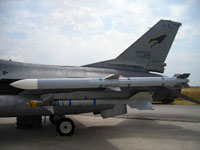The AIM-9 Sidewinder is a supersonic, heat-seeking,
air-to-air missile carried by fighter aircraft. It has a
high-explosive warhead and an active infrared guidance system.
The Sidewinder was developed by the US Navy for fleet air defence and
was adapted by the US Air Force for fighter aircraft use. Early
versions of the missile were extensively used in the Southeast Asian
conflict. In September 1958 Chinese Nationalist F-86s fired the first
Sidewinder air-to-air missiles to down 11 communist Chinese MiG-17s
over the Formosa Straits.
Until that time, aircraft defensive means were
primarily limited to pilots and tail gunners firing small calibre
ammunition in dog-fight situations.
The AIM-9 has a cylindrical body with a roll-stabilizing rear wing/rolleron
assembly. Also, it has detachable, double-delta control surfaces
behind the nose that improve the missile's manoeuvrability. Both
rollerons and control surfaces are in a cross-like arrangement.
The missile's main components are an infrared homing guidance section,
an active optical target detector, a high-explosive warhead, and a
rocket motor.
The infrared guidance head enables the missile to home on target
aircraft engine exhaust. An infrared unit costs less than other types
of guidance systems, and can be used in day/night and electronic
countermeasures conditions.
The infrared seeker also permits the pilot
to launch the missile, then leave the area or take evasive action
while the missile guides itself to the target.
|
AIM-9 SIDEWINDER Specifications |
|
Type |
Short range
heat seeking missile |
|
Manufacturer |
Raytheon |
|
Weight |
190lb (91kg) |
|
Warhead |
20.8lb (9.4kg) annular blast-fragmentation |
|
Length |
9ft 4in (2.9m) |
|
Diameter |
5in (127mm) |
|
Wingspan |
25in (650mm) |
|
Performance |
Max speed Mach 2.5,
range 1-18km, guidance infrared homing |

